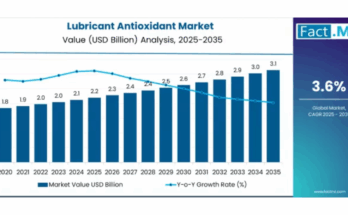The global thermic fluids market is set for sustained and long-term expansion, supported by rising industrial energy efficiency requirements, rapid adoption of renewable technologies, and ongoing innovations in heat transfer systems. According to a new analysis by Fact.MR, the market is projected to grow from USD 11.8 billion in 2025 to USD 15.9 billion by 2035, marking an absolute increase of USD 4.1 billion and reflecting a CAGR of 3.0% over the forecast period.
Thermic fluids—widely used in concentrated solar power (CSP), chemical processing, food and beverage operations, pharmaceuticals, HVAC systems, and oil & gas facilities—play a crucial role in efficient heat transfer, temperature control, and energy optimization across industries.
As industries transition toward cleaner technologies and demand for high-performance heat transfer solutions rises, thermic fluids are increasingly in demand across both established and emerging markets.
Strategic Market Drivers
Industrial Energy Efficiency Gains Priority
Industries worldwide are working to optimize thermal processes and reduce energy consumption. Thermic fluids offer superior heat stability, reduced fuel requirements, and consistent system performance. Sectors including chemical manufacturing, plastics, metal processing, and food production are expanding their use of high-temperature synthetic and mineral-based fluids to meet efficiency and safety standards.
Renewable Energy & CSP Systems Accelerate Adoption
The global shift toward renewable energy—especially concentrated solar power (CSP)—is significantly boosting demand. Thermic fluids enable heat collection and transfer in solar power plants, supporting higher thermal storage, longer operational hours, and improved plant efficiency. Growing investments in solar infrastructure across the Middle East, Europe, China, and India continue to transform market dynamics.
Rising Demand for Safe, High-Performance Heat Transfer Solutions
Modern industrial applications require fluids with low volatility, superior oxidation resistance, and high thermal stability. Manufacturers are increasingly developing specialty synthetic fluids, glycol-based solutions, and eco-efficient formulations tailored to varying temperature ranges and regulatory requirements.
Browse Full Report: https://www.factmr.com/report/thermic-fluids-market
Regional Growth Highlights
North America: Strong Industrial Base and Technological Advancements
North America remains a leading contributor due to ongoing upgrades in chemical plants, oil and gas facilities, and food processing industries. The U.S. shows strong adoption of high-temperature synthetic fluids and renewable energy applications.
Europe: Sustainability and Renewable Energy Lead Market Expansion
Europe is experiencing rising installations of solar thermal systems and strict environmental regulations. Countries such as Germany, Spain, Italy, and France are focusing on energy-efficient thermal systems and sustainable heat transfer solutions.
East Asia: Rapid Industrialization and Infrastructure Growth
China, Japan, and South Korea are witnessing a surge in chemical processing, manufacturing, and industrial heating applications. Growing investments in solar thermal and district heating systems are strengthening regional demand.
Emerging Markets: High Growth Potential
India, Southeast Asia, Latin America, and the Middle East are emerging as significant growth pockets due to expanding industrial sectors, refinery upgrades, and investments in renewable energy infrastructure.
Market Segmentation Insights
By Type
- Mineral Oils – Widely adopted due to cost-efficiency and broad industrial use.
- Synthetic Fluids – Fast-growing segment offering high thermal stability and long service life.
- Silicone & Aromatic Fluids – Preferred for extreme-temperature applications.
- Glycol-Based Fluids – Increasing use in HVAC and food-grade applications.
By End-Use Industry
- Chemical Processing – Largest segment driven by continuous production operations.
- Oil & Gas – Used in refining, heat recovery, and petrochemical transformations.
- Food & Beverage – Demand rising for safe, food-grade thermal oils.
- Renewable Energy (CSP) – Fastest-growing area due to global solar investments.
- Pharmaceuticals – Growing due to precise temperature-controlled manufacturing.
- HVAC & Others – Increasing adoption in large-scale heating systems.
Challenges Impacting Market Growth
- Environmental Regulations – Stricter chemical and emissions guidelines increase compliance costs.
- High Cost of Synthetic Fluids – Limits adoption among small and mid-sized manufacturers.
- Thermal Degradation & Maintenance Needs – Efficiency declines over time require expensive system monitoring.
- Volatility in Raw Material Prices – Impacts production economics for mineral-based fluids.
Competitive Landscape
The thermic fluids market is moderately consolidated, with major players focusing on product innovation, fluid durability, and sustainability initiatives.
Key Companies Profiled
- Dow Chemical
• Eastman Chemical Company
• ExxonMobil
• BP PLC
• Huntsman Corporation
• Chevron
• BASF SE
• Shell PLC
• Paratherm
• Radco Industries
Manufacturers are developing eco-friendly thermal oils, extending fluid service life, improving oxidation resistance, and offering on-site fluid analysis services to enhance system reliability.
Recent Developments
- 2024: Launch of ultra-high-temperature synthetic fluids supporting next-generation CSP systems and industrial heating.
- 2023: Expansion of food-grade and glycol-based thermic fluids across food & beverage and HVAC sectors in North America and Europe.
- 2022: Introduction of bio-based thermal oils and low-emission formulations in alignment with global sustainability goals.
Future Outlook: A Decade of Industrial Thermal Innovation
The next decade will witness strong demand for thermic fluids driven by industrial modernization, renewable energy installations, and sustainability-focused heat transfer solutions. Advancements in fluid formulation, longer lifecycle stability, environmentally responsible alternatives, and smart monitoring systems will shape market growth.
With broadening applications across multiple industries and rising investments in clean energy, the thermic fluids market is positioned for steady and resilient global expansion through 2035.



